Weaving Their Way Into
History
by Bob Brooke
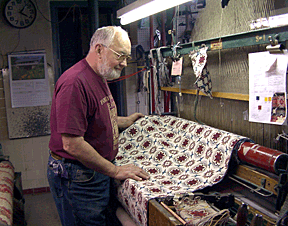 In the world of antiques, many people
frown on reproductions, but at Family Heir-Loom Weavers of Red Lion,
just outside of York, Pennsylvania, history is a precious commodity.
Here, in a former Meadow View Dairy milk bottling plant, David and
Carole Kline and their son, Patrick, re-create historic fabrics and
carpets for use in re-enactments and historic homes. In the world of antiques, many people
frown on reproductions, but at Family Heir-Loom Weavers of Red Lion,
just outside of York, Pennsylvania, history is a precious commodity.
Here, in a former Meadow View Dairy milk bottling plant, David and
Carole Kline and their son, Patrick, re-create historic fabrics and
carpets for use in re-enactments and historic homes.
David Kiine, now 73, began his career in weaving as a loom cleaner
just after high school. From there, he moved up to cut boy taking fabric
off the looms, and then on to weaver. He learned so much about the looms
that eventually he became a loom fixer. But the company Kline worked for
used only plain looms. After it closed in 1955, he got a job at a York
factory which used jacquard looms.
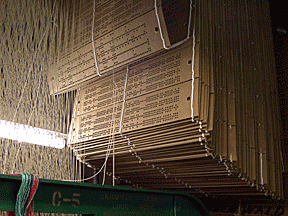 In the mid-19th Century, Joseph Jacquard invented a weaving system
that relied on stiff, pasteboard cards, punched with various patterns of
holes. At each throw of the loom’s shuttle, the weaver placed a card
in the path of the rods. Thus, the pattern of holes in the card, acting
as a program for the loom, determined which rods could pass through,
enabling weavers to create complex designs. In the mid-19th Century, Joseph Jacquard invented a weaving system
that relied on stiff, pasteboard cards, punched with various patterns of
holes. At each throw of the loom’s shuttle, the weaver placed a card
in the path of the rods. Thus, the pattern of holes in the card, acting
as a program for the loom, determined which rods could pass through,
enabling weavers to create complex designs.
When the second company folded, Kline got a job at Caterpillar, but
weaving was in his blood, so when he got laid off from that job in 1982,
he and his wife began Family Heir-Loom Weavers and Kline was once again
in his element. At first, Kline produced only coverlets, but soon
received requests for table runners, and eventually expanded into making
placemats, tablecloths, pillows, and other household items on his
jacquard looms since he had control of every thread of the warp,
enabling him to create figural designs.
"I had orders for 100 coverlets before opening my
business," said Kline. He produces 25 different coverlet designs on
looms such as a 1935 model salvaged from Philadelphia University
(formerly Philadelphia College of Textiles and Science). Most of Kline’s
32 looms, warping wheels, and other equipment came from now-defunct
factories like the Blue Bird Silk Mill on Hartley and Maryland Avenues
in York, Pennsylvania. They date as early as 1900, but most are from the
1930s through the 1960s.
"Historical accuracy is important to us," added Kline,
"so we reproduce the elaborate borders and subjects of the
1830-1850 period. Customers can also have their names, sayings or dates
woven into commissioned coverlets." The Klines also sell pre-made
coverlets without personalization for customers who want to use them to
enhance their antique-filled interiors.
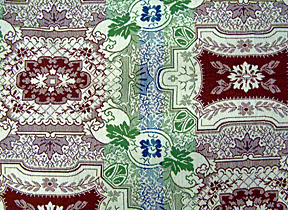 Each coverlet is woven in two halves on jacquard looms and hand
seamed just as they were in the early 19th Century. Kline
weaves coverlets in patterns such as the Eagle, House, Pine and Bush,
and Railroad, in a variety of colors. Then he personalizes each
coverlets with a signature block at the corner which says, "Wove by
David Kline/Red Lion/PA." followed by the customer's name and the
date if woven to order. Some clients include an anniversary or birthday
date. Each coverlet is woven in two halves on jacquard looms and hand
seamed just as they were in the early 19th Century. Kline
weaves coverlets in patterns such as the Eagle, House, Pine and Bush,
and Railroad, in a variety of colors. Then he personalizes each
coverlets with a signature block at the corner which says, "Wove by
David Kline/Red Lion/PA." followed by the customer's name and the
date if woven to order. Some clients include an anniversary or birthday
date.
William Brown, a ranger for the National Park Service, called Kline
to ask him if he knew of anyone who could reproduce a carpet for Abraham
Lincoln's house in Illinois. And so Kline embarked on yet another facet
of his business, making reproduction ingrain carpets, which now
represent about a third of his company’s volume.
Family Heir-Loom Weavers’ ingrain carpets now enhance the interiors
of a number of historic house museums of former U.S. presidents,
including Abraham Lincoln (5 rooms), George Washington (2 rooms), Andrew
Jackson (2 rooms), Martin Van Buren ((2 rooms), James Buchanan (4
rooms), Ullysses S. Grant (2 rooms) and Woodrow Wilson (1 room). The
Surrender Room at Appomattox Court House in Virginia, Washington
Irving's "Sunnyside" in Tarrytown, New York, Walt Whitman s
home in Long Island, and Mark Twain's house in Hannibal, Missouri are
among the many others. His product has appeared in numerous historical
films as well.
Popular during most of the 19th Century and affordable for
the rising middle class as a moderately priced alternative to
hand-loomed Brussels carpets and hand-knotted Axminsters, ingrain
carpets range from 9 to 54 inches wide, though most are 36 inches.
Room-sized carpets like these have to be handstitched together, just as
they were during the peak of their popularity. Homeowners laid them
wall-to-wall over wide-board pine floors. Mid-19th-century tastes
dictated bold colors and multiple patterns in decorating a room, and
these carpets completed the look.
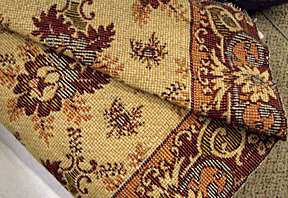 Family Heir-Loom Weavers produces 20 patterns of ingrain carpets as
well as four types of stair runners in a variety of colors. When Kline
first began weaving ingrain carpets, he had to have the designs
re-created by textile designers. Today, he just sends a scrap of
original carpet to the firm of Patterson Card Cutters, and they set the
pattern on their computers, returning the cards to him to use in on his
looms. On some of this machinery, the firm also makes dimity fabric for
historic bed hangings. Family Heir-Loom Weavers produces 20 patterns of ingrain carpets as
well as four types of stair runners in a variety of colors. When Kline
first began weaving ingrain carpets, he had to have the designs
re-created by textile designers. Today, he just sends a scrap of
original carpet to the firm of Patterson Card Cutters, and they set the
pattern on their computers, returning the cards to him to use in on his
looms. On some of this machinery, the firm also makes dimity fabric for
historic bed hangings.
But the company is probably best known for its varied line of Civil
War-Era fabrics. Patrick Kline, became involved in Civil War
re-enactments when he was younger, participating in the 1976
Bicentennial re-enactment in Gettysburg. He researched the fabric types
and began weaving shirting in his garage. Eventually, he began
producing a full line of fabrics for Confederate and Union uniforms and
period clothing.
"Most Confederate uniforms were made of jean cloth, which has a
twill weave," said the elder Kline. "We make a lot of this
fabric and also weave worsted wool tape for chevrons [sergeant's
stripes] and for suspender straps."
Family Heir-Loom Weavers collection of 19th-Century reproduction yard
goods–kerseys (coarse, woolen fabric), broadcloths (stout woolen cloth
with a smooth finish over 29 inches wide), shirtings (used for ladies’
blouses and mens’ shirts), jeans (twilled cotton cloth, plain or
striped), satinets (a thinner, cheaper version of satin mixed with
wool), linings, and blankets–is impressive. The Klines offer shirtings
in a variety of plaids and stripes representative of those worn by
Confederate troops. But they also weave the cloth to make civilian
shirts, vests, and haversacks.
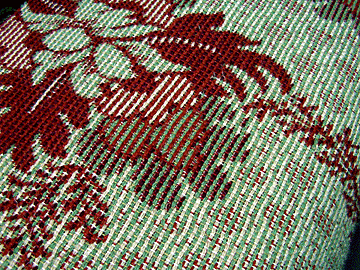 Over the last six years, the company has been asked to provide
fabrics and carpets for a number of Hollywood films. Their first was the
remake of "Washington Square," in 1997, which featured
numerous Family Heir-Loom ingrain carpets. And being new to the workings
of Hollywood, Kline didn’t fair so well on the business side, ending
up with only a credit at the end of the film. But experience is a great
teacher, and he went on to work with other producers, including Steven
Speilberg for his movie "Amistad" and the producers of
"Gods and Generals," a prequal to a film on the Battle of
Gettsyburg. Over the last six years, the company has been asked to provide
fabrics and carpets for a number of Hollywood films. Their first was the
remake of "Washington Square," in 1997, which featured
numerous Family Heir-Loom ingrain carpets. And being new to the workings
of Hollywood, Kline didn’t fair so well on the business side, ending
up with only a credit at the end of the film. But experience is a great
teacher, and he went on to work with other producers, including Steven
Speilberg for his movie "Amistad" and the producers of
"Gods and Generals," a prequal to a film on the Battle of
Gettsyburg.
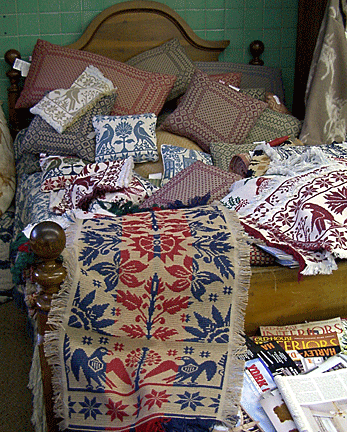 His latest venture involved producing blanket and clothing fabric for
"Cold Mountain," Charles Frazier's odyssey of a wounded
Confederate soldier walking home to North Carolina in the waning months
of the Civil War. This was the firm’s biggest movie order yet. The
film’s costume designer, Ann Roth, who received an Academy Award for
her designs in "The English Patient," visited the small
factory to personally order the materials. When they finished the order,
Roth had the fabrics shipped to Romania to be assembled into uniforms
and blankets. His latest venture involved producing blanket and clothing fabric for
"Cold Mountain," Charles Frazier's odyssey of a wounded
Confederate soldier walking home to North Carolina in the waning months
of the Civil War. This was the firm’s biggest movie order yet. The
film’s costume designer, Ann Roth, who received an Academy Award for
her designs in "The English Patient," visited the small
factory to personally order the materials. When they finished the order,
Roth had the fabrics shipped to Romania to be assembled into uniforms
and blankets.
Patrick Kline is a favorite among Civil War re-enactors because of
the authenticity of his materials. His main interest is making fabrics
used by individual Civil War reenactors. "Our customers want to
make the best impression they can out there," Kline said.
"They want their impressions to do justice to the people who fought
in those battles."
Family Heir-Loom Weavers coverlets and carpets are the perfect
complement to an antique-filled interior, and their fabrics make the
Civil War and other time periods come alive in the field. To see samples
of their work, visit their Web site.
<
Back to
More Special Features
Next
Article >
|
